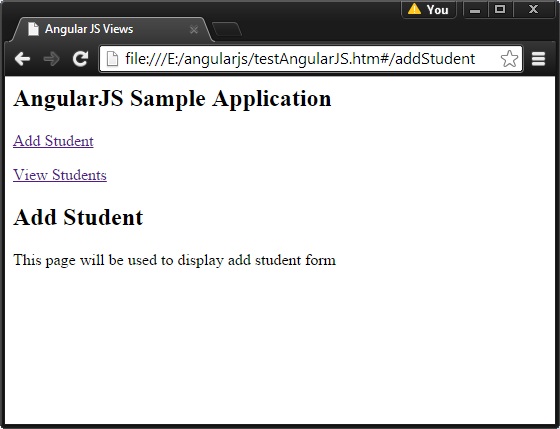
AngularJS supports single page applications via multiple views on a single page. To do this AngularJS provides ng-view and ng-template directives, as well as the $routeProvider service.
ng-view
ng-view tag simply creates a placeholder for a corresponding view (HTML or ng-template view) that can be placed according to the configuration.
Use
Define a div and ng-view in the main module.
<div ng-app="mainApp"> ... <div ng-view></div> </div>
ng-template
Theng-template directive is used to create HTML views using script tags. It contains an "id" attribute for the controller view mapped by $routeProvider.
Use
Define the type as a script block for ng-template in the main module.
<div ng-app="mainApp">
...
<script type="text/ng-template" id="addStudent.html">
<h2> Add Student </h2>
{{message}}
</script>
</div>
$routeProvider
$routeProvider is a configuration that groups URLs, maps them to the corresponding HTML page or ng-template, and attaches a controller to the service using the same key.
Use
Define the type as a script block for ng-template in the main module.
<div ng-app="mainApp">
...
<script type="text/ng-template" id="addStudent.html">
<h2> Add Student </h2>
{{message}}
</script>
</div>
Use
Define the script block of the main module and set the routing configuration.
var mainApp = angular.module("mainApp", ['ngRoute']);
mainApp.config(['$routeProvider',
function($routeProvider) {
$routeProvider.
when('/addStudent', {
templateUrl: 'addStudent.html',
controller: 'AddStudentController'
}).
when('/viewStudents', {
templateUrl: 'viewStudents.html',
controller: 'ViewStudentsController'
}).
otherwise({
redirectTo: '/addStudent'
});
}]);
The following are important issues to consider in the above example
Example
The following example will demonstrate all the above commands.
testAngularJS.html
<html>
<head>
<title>Angular JS Views</title>
<script src="http://ajax.googleapis.com/ajax/libs/angularjs/1.2.15/angular.min.js"></script>
<script src="http://ajax.googleapis.com/ajax/libs/angularjs/1.2.25/angular-route.min.js"></script>
</head>
<body>
<h2>AngularJS Sample Application</h2>
<div ng-app="mainApp">
<p><a href="#addStudent">Add Student</a></p>
<p><a href="#viewStudents">View Students</a></p>
<div ng-view></div>
<script type="text/ng-template" id="addStudent.html">
<h2> Add Student </h2>
{{message}}
</script>
<script type="text/ng-template" id="viewStudents.html">
<h2> View Students </h2>
{{message}}
</script>
</div>
<script>
var mainApp = angular.module("mainApp", ['ngRoute']);
mainApp.config(['$routeProvider',
function($routeProvider) {
$routeProvider.
when('/addStudent', {
templateUrl: 'addStudent.html',
controller: 'AddStudentController'
}).
when('/viewStudents', {
templateUrl: 'viewStudents.html',
controller: 'ViewStudentsController'
}).
otherwise({
redirectTo: '/addStudent'
});
}]);
mainApp.controller('AddStudentController', function($scope) {
$scope.message = "This page will be used to display add student form";
});
mainApp.controller('ViewStudentsController', function($scope) {
$scope.message = "This page will be used to display all the students";
});
</script>
</body>
</html>
Results
Open textAngularJS.html in your web browser. See the results as follows:

 What does data intelligence mean?
What does data intelligence mean?
 How to install ssl certificate
How to install ssl certificate
 Introduction to output devices in computers
Introduction to output devices in computers
 Introduction to screenshot shortcut keys in Windows 7 system
Introduction to screenshot shortcut keys in Windows 7 system
 The role of float() function in python
The role of float() function in python
 Dogecoin latest price today
Dogecoin latest price today
 The main reason why computers use binary
The main reason why computers use binary
 Window switching shortcut keys
Window switching shortcut keys




